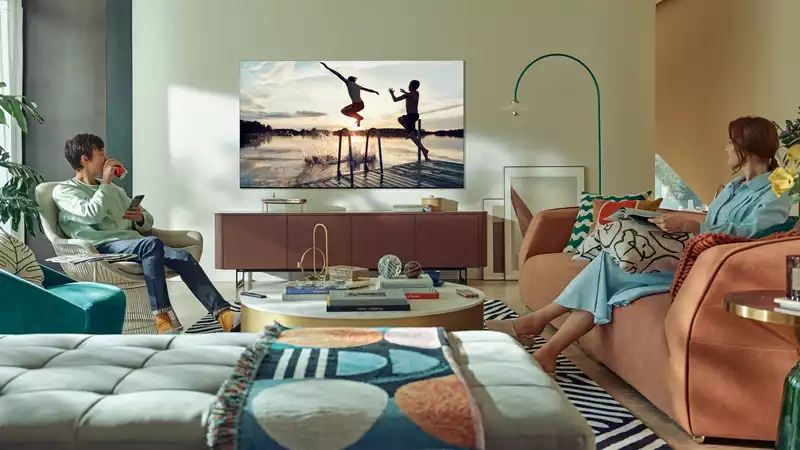Samsung has announced its 2021 TV lineup, and while new 8K and 4K models were expected, Samsung has brought a variety of enhancements to its latest smart TVs
From new display technologies like Micro-LED and Mini-LED, to environmentally friendly packaging, to super convenient updates to remotes, Samsung wowed us with TVs due in the coming months
The first big change is what Samsung calls Neo QLED, a new version of QLED that will be featured on its 8K QN900A and 4K QN90A flagship TVs in 2021 Neo QLED is Samsung's quantum dot enhanced display refined with quantum matrix technology It is Samsung's catch-all term for the mini-LED backlight and its related features
By uniquely combining micron-scale LED backlighting with a tiny diffusion layer applied to each diode, Samsung's Neo QLED 8K and 4K TVs can achieve brighter backlighting and deeper brightness gradients
The smaller LEDs allow for denser backlight zones and tighter control of the backlight, resulting in deeper black levels and brighter highlights while reducing halos seen in current LCD and QLED TVs This is a major step toward blurring the line between QLEDs and OLEDs and should be a marked improvement over last year's QLED sets [The smaller LEDs will also result in a slimmer chassis design, so the Neo QLED set will be made thinner with Samsung's essentially bezel-less Infinity Edge screen
Samsung's top-of-the-line model also has a new OneConnect box in a smaller, less conspicuous package; the OneConnect box allows the display to be as slim as possible, with only the display panel and speakers on the TV The video processing and various HDMI and USB inputs are offloaded to a separate box and connected via a single cable (which also serves as the TV's power cable)
This new slim design can be placed in an entertainment center or mounted behind a TV stand out of sight
Samsung's new Neo Quantum Processor is more than just an enhanced chip Samsung had previously touted AI-based upscaling and video processing, and the new processor uses a combination of multiple simultaneous machine learning processes ("up to 16 different neural network models," according to Samsung) to optimize various elements of image quality
Samsung's Object Tracking Sound is back, providing a more realistic and immersive experience by allowing audio to follow along with on-screen objects and actors; Q-Symphony is also back, using Samsung's soundbar on Samsung TVs; and Samsung's Dolby Atmos and Dolby Atmos Simulation are back, using a Samsung soundbar on a Samsung TV, can use all speakers in concert to provide a wider, higher soundstage, with better support for Dolby Atmos and simulated surround sound
Samsung did not release details about specific models or pricing, but thanks to Samsung's leaked list of new model names and screen sizes, that news may already be available
Samsung will also unveil its first consumer micro-LED TV this year, appropriately named the Samsung Micro-LED TV This new set, an improved version of "The Wall" that Samsung has been showing off for the past few years, will use microscopic LEDs as individual pixels on the TV to create a self-illuminating display that rivals OLEDs in picture quality
Samsung touts MicroLED technology as longer lasting and more durable than OLED's O-infused organic materials, with no burn-in or color shift after several years of use
MicroLED also features Samsung's Ambient Mode, a low-power option that allows the display to blend into its surroundings when not in use
While Samsung still touts the modular capabilities of its MicroLED modules, MicroLED TVs are single-size displays pre-assembled in standard aspect ratios (Frankly, the modular aspect always seems to be more relevant to signage than to home TVs)
Because the screen is so large, Samsung has also introduced Quad View, which divides the screen into four sections, each of which can operate with separate inputs The larger size means that each Quad View section of the display can be used as a separate 1080p TV, allowing people to watch sporting events simultaneously, play games side-by-side, or have family members enjoy different programs at the same time With Samsung's mobile app, viewers can also listen to each video separately through headphones
Samsung initially announced only a larger 110-inch model of the MicroLED TV, but today's announcement expands this to an additional model, a 99-inch model, and promises a "smaller version by the end of the year"
Samsung's solar cell remote control solves a common irritation by removing replaceable batteries from the remote control and replacing them with rechargeable batteries and solar cells that can charge the remote using indoor lighting in the living room
Samsung packaging is becoming a bit more environmentally friendly with a new low-ink design that reduces printing waste and makes cardboard easier to recycle The new packaging also uses a new ink that is more sustainable than the oil-based inks traditionally used for TV packaging
Samsung's accessibility features have been greatly enhanced, including voice guidance for the blind, high-contrast viewing modes, and smart captioning for deaf users










Comments